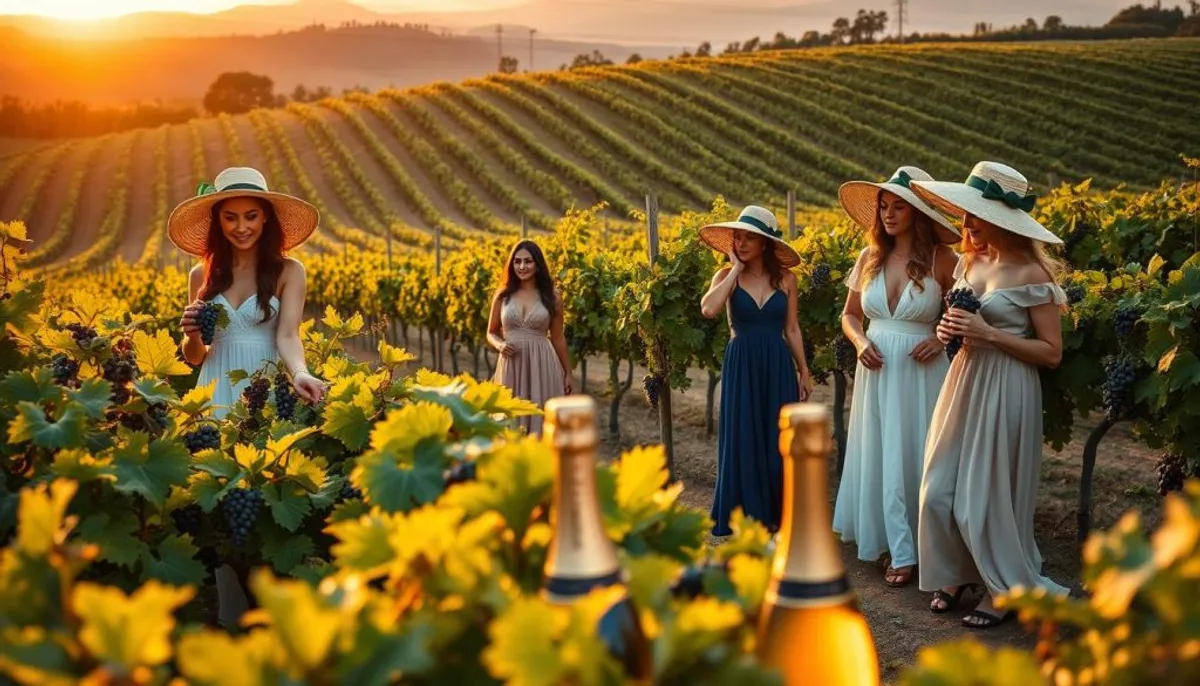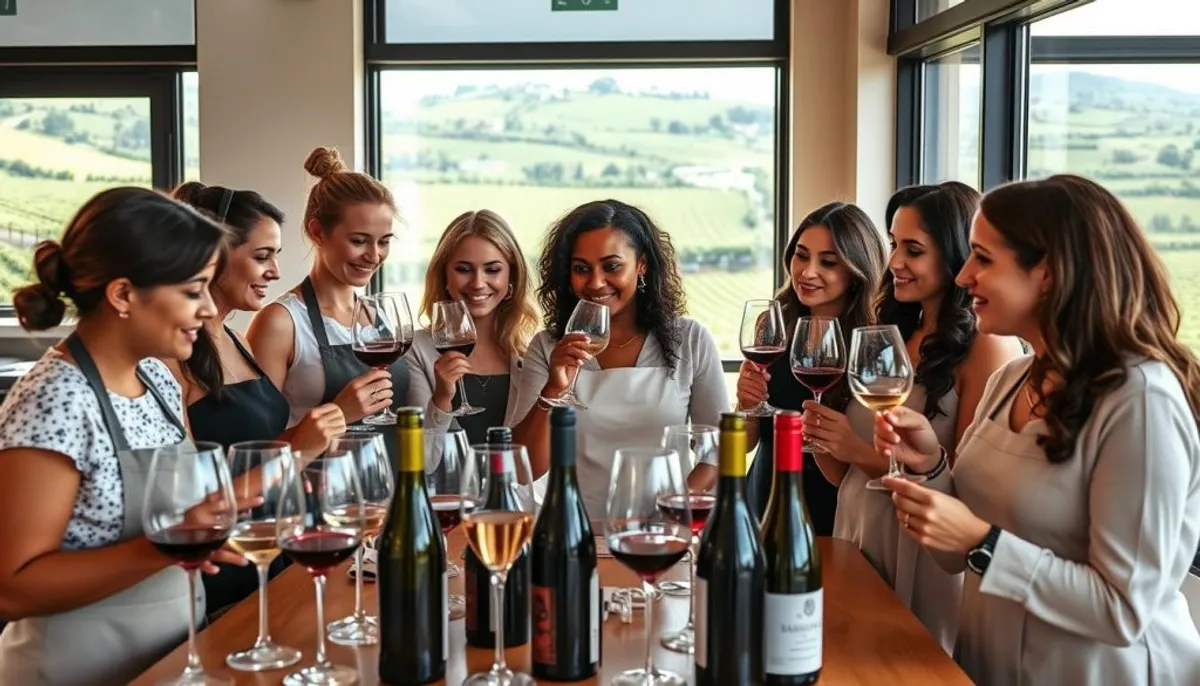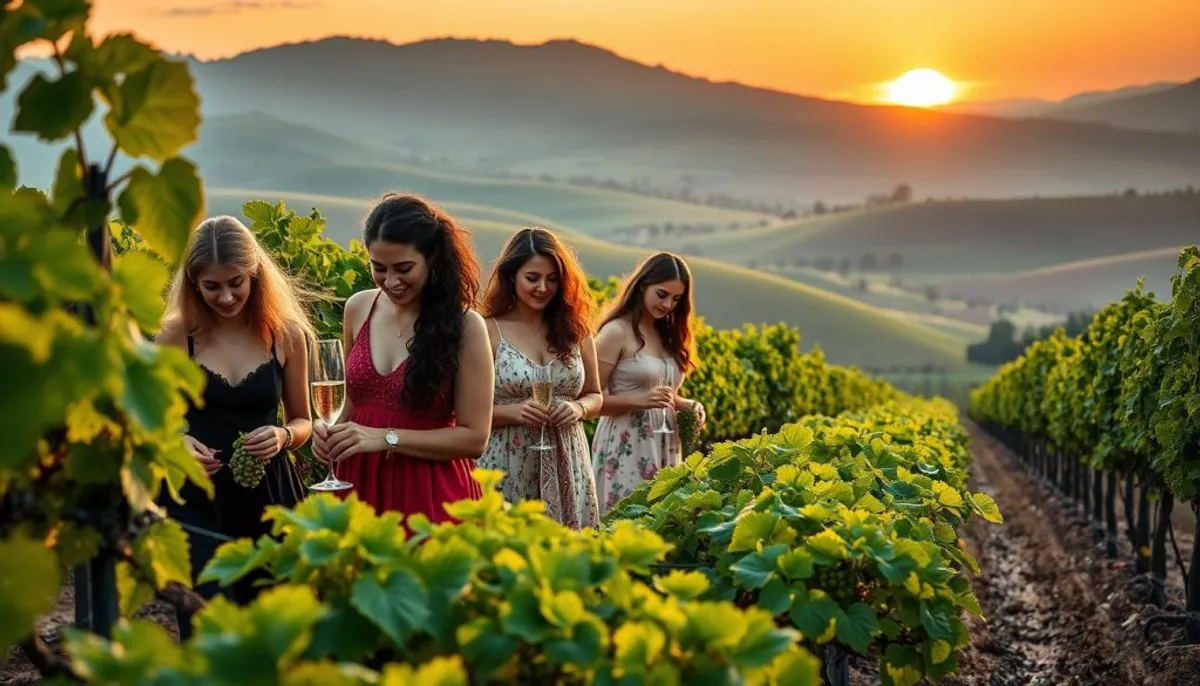The sparkling wine industry has been profoundly influenced by the contributions of women in Champagne. From the historic “Champagne widows” to today’s pioneering female winemakers, these trailblazers have etched a lasting impact on the world of bubbly.
Champagne Duval-Leroy exemplifies female leadership in the industry. Established in 1859, it stands as one of the few 100% family-owned Champagne houses. Carol Duval-Leroy, alongside her three sons, leads this esteemed firm, ranking among the top 15 Champagne producers.

The influence of women extends beyond ownership. In 2005, Sandrine Logette-Jardin became the first female Chef de Caves at Duval-Leroy, opening doors for other women in critical winemaking positions. This shift is mirrored in the broader industry, where about one-third of Champagne’s 26,800 employees are now women.
Female winemakers are not only breaking barriers; they’re setting new benchmarks. Duval-Leroy was the first to produce a certified organic Brut Champagne, exemplifying innovation in sustainable practices. Their wines have garnered recognition, being the only Champagne selected for Wine Spectator’s Top 100 in 2008.
Key Takeaways
- Women play a crucial role in shaping the Champagne industry
- Champagne Duval-Leroy is a leader in female representation
- One-third of Champagne industry employees are women
- Female winemakers are driving innovation in sustainable practices
- Women are increasingly taking on leadership roles in Champagne houses
The Legacy of Women in Champagne’s History
Women have been instrumental in shaping Champagne’s history, leaving a lasting impact on the industry. Their contributions span centuries, transforming production methods and expanding global markets.
The Pioneering Widows: Clicquot, Pommery, and Bollinger
Veuve Clicquot, Madame Pommery, and Lily Bollinger are renowned as pioneers in the Champagne world. Barbe-Nicole Ponsardin Clicquot introduced the riddling table and created the first known blended rosé champagne. Louise Pommery, in 1874, pioneered dry champagne, catering to British tastes. Lily Bollinger, who took over Bollinger in 1941, introduced late disgorged wines in 1952. Today, engraved champagne gifts are a popular choice for celebrating milestones and special occasions in the Champagne industry.
Revolutionary Innovations by Female Leaders
These women’s innovations have been foundational to modern Champagne production. Veuve Clicquot’s riddling table improved clarity, while Madame Pommery’s use of chalk pits for aging bottles enhanced flavor profiles. Their leadership opened new markets in Russia and England, expanding Champagne’s global reach.
Breaking Ground in Traditional Wine Making
Despite facing challenges in a male-dominated industry, women continue to make strides. Today, 18 prestigious Champagne houses are led by female Chef de Caves. Organizations like La Transmission—Femmes en Champagne support women’s recognition and promotion in the industry.
| Statistic | Value |
|---|---|
| Women Champagne house owners | Less than 10% |
| Women in Champagne industry jobs | One-third of 26,800 |
| Female enology students in Champagne | 60% |
| Women Chef de Caves in history | 7 |
The legacy of these pioneering women continues to inspire future generations in the Champagne industry, driving innovation and excellence in winemaking.
Femme de Champagne: Modern Trailblazers
The Champagne industry has witnessed a significant increase in female leadership. Women have made substantial progress in roles previously dominated by men. Currently, about one-third of the workforce in Champagne is female, with half of them engaged in vineyards or cellars.
Carol Duval-Leroy’s Inspiring Journey
Carol Duval-Leroy took over Champagne Duval-Leroy at the age of 35, following her husband’s untimely death. She introduced the prestige cuvée “Femme de Champagne” in 1990, with its first release in 1999. This blend exemplifies Duval-Leroy’s dedication to excellence, featuring a Grand Cru NV with 95% Chardonnay and 5% Pinot Noir.
Sandrine Logette-Jardin: First Female Chef de Cave
Duval-Leroy appointed Sandrine Logette-Jardin as Head of Quality Control, a role that later evolved into the first female Chef de Caves in 2005. This milestone opened doors for other women in the industry. Julie Cavil, for instance, became the seventh Chef de Cave at Champagne Krug in 2019.
Contemporary Female Leadership in Champagne Houses
Today, female leaders in Champagne continue to leave their indelible mark. Apolline Godinot Henriot founded Champagne Henriot, with Alice Tétienne now leading as Chef de Cave. At Domaine Carneros, more than half of the management team is comprised of women. These trailblazers are driving innovation, with Duval-Leroy pioneering the first certified organic Brut Champagne. Carol Duval-Leroy also holds the distinction of being the first female President of the Association Viticole Champenoise.
| Statistic | Value |
|---|---|
| Women in Champagne industry | 33% |
| Women in vineyards or cellars | 50% |
| Female enology students in Champagne | 60% |
Challenges and Triumphs in a Male-Dominated Industry
Women in viticulture encounter distinct hurdles within the Champagne sector. The quest for gender parity in the wine world persists. They endeavor to secure technical positions in vineyards and cellars, aiming to shatter the glass ceiling.
The quest for work-life balance is a formidable challenge for women in the wine industry. The demands of long hours and the intense nature of harvest seasons often clash with family obligations. Yet, female winemakers are carving out significant achievements, exploring various laminate flooring options to enhance their tasting rooms and production spaces.
The 2023 drama film “Widow Clicquot” brings to light the trailblazing endeavors of women in Champagne. This narrative, inspired by Barbe-Nicole Clicquot Ponsardin’s life, underscores the historical challenges and victories of women in this field.
Significant progress is evident in the rising number of female sommeliers and winemakers. Over the last two decades, the proportion of women in French wine estates has nearly doubled. This uptick signifies the evolving industry landscape and the unwavering resolve of women to excel.
| Year | Women in French Wine Estates | Notable Achievements |
|---|---|---|
| 2000 | 14% | Limited representation |
| 2010 | 21% | Increasing presence in technical roles |
| 2020 | 28% | Leadership positions in major Champagne houses |
Women’s Impact on Champagne Production Techniques
Women have transformed Champagne production, introducing new perspectives and methods. Their contributions extend to winemaking, sustainable practices, and quality control, enriching the sparkling wine culture. This has significantly impacted the industry.
Innovative Winemaking Approaches
Female winemakers in Champagne have pioneered advanced techniques. They excel in blending, a critical skill given the region’s weather variability. This expertise enables them to craft wines that embody the essence of Champagne, maintaining its esteemed reputation.
Sustainable and Organic Practices
Women-led Champagne houses are pioneering sustainable winemaking. They adopt organic and biodynamic methods, minimizing environmental harm while producing premium organic Champagne. This transition aligns Champagne with other leading wine regions, emphasizing eco-consciousness and enhancing the sparkling wine culture.
Quality Control and Certification Standards
Female leaders have elevated quality standards in Champagne. They’ve established stringent certification protocols, ensuring every bottle meets high expectations. Duval-Leroy, for example, was the first to achieve ISO 9002 certification for its quality management system. This achievement sets a new standard for the industry.
| Aspect | Women’s Contribution | Impact |
|---|---|---|
| Winemaking | Innovative blending techniques | Consistent quality despite weather challenges |
| Sustainability | Organic and biodynamic practices | Reduced environmental impact, higher quality |
| Quality Control | Implementation of certification standards | Improved consistency and excellence |
Female-Led Organizations and Support Networks
The Champagne industry has witnessed a notable increase in women’s participation. Currently, women comprise half of the total workforce in the Champagne sector, as reported by the French Institute of Statistics. This trend is mirrored in educational settings, with 60 percent of enology students in Champagne being female.
Women of the Vine and Spirits, Women Do Wine, and Femmes de Champagne are pivotal in promoting female leadership. These organizations serve as platforms for knowledge exchange, collaboration, and recognition.
In Champagne, La Transmission—Femmes en Champagne and Les Fa’Bulleuses de Champagne stand out in promoting women’s roles. These groups foster a spirit of camaraderie among female winemakers, encouraging a non-competitive environment.
The influence of these networks is clear in the rising number of women in leadership roles. For instance, Julie Cavil became the seventh woman to hold the title of Chef de Cave at Champagne Krug in 2019. At Henriot, Chef de Cave Alice Tétienne draws inspiration from her grandmother, who owned a vineyard.
| Organization | Focus Area |
|---|---|
| Women of the Vine and Spirits | Global networking and career development |
| Women Do Wine | Education and mentorship |
| Femmes de Champagne | Champagne-specific support and promotion |
| La Transmission | Knowledge sharing in Champagne industry |
| Les Fa’Bulleuses de Champagne | Collaboration among female winemakers |
The Rise of Women Sommeliers and Wine Educators
Women are significantly advancing in the realms of wine education and service. The landscape of female sommeliers and educators is rapidly evolving. More women are achieving high-level certifications, breaking barriers in traditionally male-dominated roles, and exploring opportunities in areas like craft accessories.
Educational Achievements and Certifications
The wine education sector has witnessed a notable increase in female participation. Currently, women comprise 43% of Wine and Spirit Education Trust (WSET) Diploma graduates. This is a substantial rise from the 11% in the 1970s. The trend extends to other prestigious certifications, with 35% of Masters of Wine being women. In the context of sparkling wines, a prosecco champagne comparison can help consumers understand the differences and similarities between these popular choices.
Organizations like the Champagne Academy and Wine Scholar Guild offer specialized programs. These programs provide opportunities for further education in wine, including a comprehensive champagne price guide. Initiatives such as these have paved the way for talented individuals. For example, Charlotte Gordon gained a scholarship from Women of the Vine & Spirits Foundation to study champagne. She now works for Moët Hennessy.
Breaking Barriers in Wine Service
Female sommeliers are making their mark in the industry. In 2013, Véronique Rivest became the first woman to reach the podium in the World’s Best Sommelier competition. This achievement has inspired more women to pursue careers in wine service.
Support networks are emerging to foster growth and connection among women in the wine industry. Queena Wong, recognized as Connector of the Year in 2023’s CODE Hospitality Women of the Year Awards, established Curious Vines. This UK-based community supports women in the wine industry.
| Certification | Female Representation |
|---|---|
| WSET Diploma Graduates | 43% |
| Masters of Wine | 35% |
| Champagne Chef de Caves | 18 great houses |

While progress is evident, challenges persist. Balancing career advancement with family responsibilities remains a hurdle for many women in the wine industry. Despite these obstacles, the increasing presence of female sommeliers and educators is reshaping the wine world. They are bringing fresh perspectives and innovations to this centuries-old industry, including trends like pop culture wine that resonate with a broader audience.
Balancing Tradition with Innovation
Women winemakers are revolutionizing modern Champagne production with innovative ideas and unique offerings, including engraved champagne gifts. They seamlessly blend ancient techniques with cutting-edge approaches. This synergy is exemplified at Duval-Leroy, a venerable Champagne house established in 1859.
Carol Duval-Leroy, CEO, spearheads this transformation. Her vision integrates consumers into the winemaking process. The vineyard has been revamped to facilitate bespoke Champagne production.
Duval-Leroy’s tasting rooms embody this modern twist. They boast minimalist aesthetics with vistas of historic chalk cellars. This design harmoniously merges tradition with innovation in Champagne.
Sustainability is a cornerstone for women-led Champagne houses. Duval-Leroy champions natural winemaking and combats water waste. They’ve implemented solar panels and a green wall with 2,500 plants, creating an optimal winemaking environment.
| Traditional Elements | Innovative Approaches |
|---|---|
| Historic chalk cellars | Modern tasting rooms |
| Time-tested winemaking methods | Consumer involvement in production |
| Classic Champagne varieties | Organic grape cultivation |
| Aging process | Solar power usage |
Women winemakers demonstrate that honoring tradition does not preclude innovation. Their pioneering spirit propels the Champagne industry forward. This ensures its enduring success and relevance in today’s world.
Women’s Influence on Global Champagne Markets
Women are transforming the Champagne industry, propelling exports and redefining marketing strategies. Their impact is profound, with females constituting 70% of Champagne buyers. This transformation has catalyzed a revolution in marketing, aiming to attract a broader consumer base through high-quality audio downloads that enhance the overall experience of Champagne appreciation.
International Market Development
Under the leadership of women, Champagne houses are achieving global acclaim. Duval-Leroy, led by Carol Duval-Leroy, is now featured in over 250 Michelin-starred restaurants worldwide. This achievement underscores the expanding role of women in expanding Champagne’s global footprint.
Brand Building and Marketing Strategies
Women are injecting new perspectives into Champagne marketing. The Bubbles Review, initiated by a woman entrepreneur, has attracted over 12,000 enthusiasts. This platform exemplifies how women are pioneering innovative engagement strategies with Champagne consumers, fostering brand loyalty.
Female Champagne specialists, such as Essi Avellan MW and Lucy Edwards, are significantly contributing to the industry. Their emphasis on unique cuvées and grower Champagnes is broadening the global market’s appeal, catering to both aficionados and casual drinkers.
| Aspect | Female Influence |
|---|---|
| Champagne Purchases | 70% by women |
| Wine Estate Leadership | 27% women-led (2010) |
| WSET Diploma Graduates | 43% women |
Despite facing hurdles, women are advancing in the Champagne sector. Their influence is reshaping global markets, driving innovation in production and marketing, and setting the stage for a more diverse and inclusive Champagne future, including the introduction of halal beverages.
Future Generations of Female Winemakers
The Champagne industry is undergoing a transformative shift in gender dynamics. Currently, women comprise approximately one-third of the 26,800 total employees, with half engaged in vineyards or cellars. This trend is expected to persist, as 60 percent of enology students in Champagne are female.
Mentorship Programs
Mentorship in Champagne is essential for cultivating future talent. Established female leaders are actively engaged in creating a more inclusive environment. Organizations such as La Transmission—Femmes en Champagne and Les Fa’Bulleuses de Champagne are dedicated to promoting women and their wines. They foster a supportive network for newcomers.
Educational Initiatives
Wine education is crucial in shaping the future of women in viticulture. The National Diploma of Oenology, once predominantly male, now sees a significant increase in female participation. Caroline Latrive, who received this diploma during a time when women comprised less than 20 percent of the field, exemplifies this progress.

Educational initiatives go beyond formal qualifications. L’Université du Vin offers specialized programs, including a six-month sommelier degree. These courses provide women with the necessary skills and knowledge to excel in various wine industry roles.
| Aspect | Female Representation |
|---|---|
| Champagne Industry Employees | 33% |
| Enology Students in Champagne | 60% |
| Management Team at Domaine Carneros | Over 50% |
The future of Champagne looks promising, with women contributing unique skills and perspectives to winemaking. As more women enter the field, they are not only breaking barriers but also reshaping the industry landscape. This ensures a diverse and innovative future for Champagne, including the rise of custom champagne gifts that celebrate special occasions and personal milestones.
Conclusion
The narrative of women in Champagne is a testament to their unwavering determination, groundbreaking innovation, and ultimate triumph. From the trailblazing widows to the contemporary pioneers, female leadership has profoundly reshaped the industry’s terrain. Today, figures like Carol Duval-Leroy and Sandrine Logette-Jardin continue to redefine the industry’s horizons, ensuring the future of sparkling wine is radiant.
The influence of women in Champagne transcends mere production. They have transformed marketing approaches, broadened global reach, and advocated for sustainable practices. With France’s staggering output of over 300 million bottles annually, women’s impact is palpable across every facet of this esteemed sector.
Looking ahead, the role of women in Champagne is poised for expansion. Mentorship schemes and educational endeavors are clearing the path for the upcoming cohort of female winemakers. Spanning the Montagne de Reims to the Côte des Blancs, women are creating outstanding wines. These wines honor tradition while embracing innovation.
The Duval-Leroy Femme de Champagne exemplifies the essence of female empowerment. It stands as a symbol of women’s skill and dedication in the industry, ideal for celebrating life’s significant moments. Whether enjoyed at weddings or relished during private dinners, it encapsulates centuries of female expertise in Champagne craftsmanship.
RelatedRelated articles



